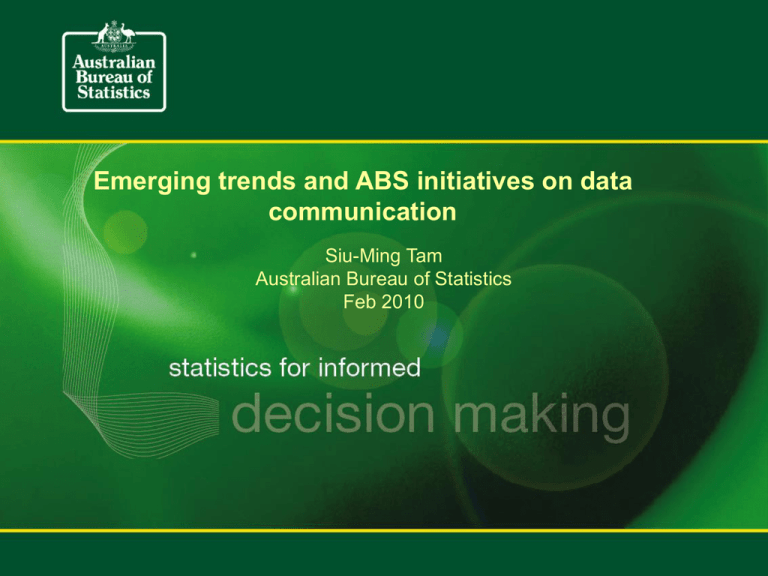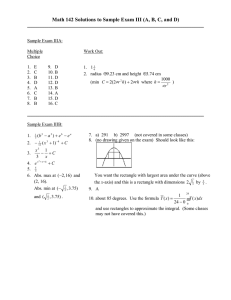
Emerging trends and ABS initiatives on data
communication
Siu-Ming Tam
Australian Bureau of Statistics
Feb 2010
Australian Bureau of Statistics,
Canberra
Where we are located in the
world
Emerging trends – personal
observations
• NSOs are continually being asked to do
more with less
– New funding model required
• More NSOs are going “paper-less” and
“price-less”
• Emerging Web and other technologies to
improve communication
– Social media
– Data visualisation tools
Emerging trends
• Micro data files become important
statistical output
• Losing grip on who the on-line
customers/clients are
– New methods of harnessing intelligence
– Web Analytics
• Investing in Statistical literacy
– Influencing curriculum development
– Education resources
• World wide growing trend for open Govt
and open access to PSI
Liberating ABS statistics
for sharing, remixing and
re-use - legally
Access to information: a key to
open government
“Public access to government held
information allows individuals to
better understand the role of
government and decisions being
made on their behalf”
Growing movement for open
Govt and access
Open access
Means
Free
Based on open standards
Freely reusable
Open licensing
grants permission to
access, re-use and
redistribute a work with few
or no restrictions
change from “All rights
reserved” to “Some rights
reserved”
What is Creative Commons?
Offers “flexible copyright management
tools for creative work”
Allows creators to choose the rights
they pass on with their work
http://www.creativecommons.org.au
Becoming the default standard
Creative Commons
Four licence elements:
1.
2.
3.
4.
Attribution
- attribute the author
Non-commercial
- no commercial use
No Derivative
Works – no changes allowed
Share alike – changes allowed,
but only if you put the new work
under the same licence
Elements combine to make up
6 licenses
Six types of CC licenses
Creative Commons widens the
use of ABS statistics
ABS adopted Creative Commons BY licence
in Dec 2008 for on line stats
Extended to customised tables
User can:
freely use, re-use, change and distribute, even
commercially
no limit to quantity of data
ABS only asks for acknowledgement as source of the data
Free access accelerates use
The ABS website averages 1.5 million page views per
week
Took 5.5 years to double from 30 million page views to 60
million before 2005; and only 2 years to double after 2005
ABS Website Activity Dec 1999 to Jan 2009
Millions*
200
CC licensing for ABS
website content Dec 08
180
160
2006 Census data 1st release
Jun 2007
140
Free publications
on web Jun 2005
120
100
80
Product Portal (new
web design)
released Jan 2005
AusStats subscription
service on web Apr 2000
Free statistics
on web Dec 2005
2001 Census data 1st
release Jun 2002
60
Publication e-sales
commence Mar 2002
40
20
0
99/00
00/01
*Number of w eb pages view ed
01/02
02/03
03/04
04/05
05/06
06/07
07/08
08/09
Open licensing encourages
innovation
• Some examples
– LobbyClue - relationships between
govt organisations and businesses
http://team7.govhack.net.tmp.anchor.n
et.au/
– Know where you live – how safe are
your neighbourhoods
http://www.hackdays.com/2009govhack/
app01/postcodes/view/2000
ABS has come a long way
From charged access to free access
From “all rights reserved” to “some rights
reserved” – ABS only requires “attribution” for
the use of our statistics
Vital step in supporting democracy and in
liberating ABS data for better decision making
ABS has come a long way…
“The ABS move is … a very significant one for
Australia …. in the international movement to
provide public access to publicly funded
resources.” - CC Australia – Dec 2008
Also, community reaction was very positive.
PS Geoscience Australia has also adopted CC 2.5 Attribution
Australia licence in December 2009.






